Possibilities for Harmonisation between Recreation Services and Their Production within the Forest Sector—A Case Study of Municipal Forest Enterprise Hradec Králové (CZ)
Abstract
1. Introduction
2. Characteristics of the MLHK Forest Enterprise
3. Methodology
3.1. Economic Data of the Forest Enterprise
3.2. Methodology of the Forest Visitors’ Attendance
3.3. Methodology of Research of the Visitors to MLHK Forests
3.4. Methodology of the Research of the Forest Visitors’ Safety
3.5. Comparison with Selected Enterprises in Urban Forests
4. Results
4.1. Financing of Recreational Services by MLHK
4.1.1. The Cost of Providing Recreational Forest Services
4.1.2. Source of Financing the Recreational Service of the Dorest
Foreign (External) Sources
MLHK’s Own (Internal) Sources
Overview of Sources of Financing the Recreational Forest Service
4.1.3. Share of Operations on the Economic Result
4.2. Recreational Forest Service
4.2.1. Attendance of the Forest
4.2.2. Characteristics of Forest Visitors
4.2.3. Safety of the Forest Visitors
4.3. Comparison with Selected Forest Enterprises in Europe
5. Discussion and Conclusions
Author Contributions
Funding
Conflicts of Interest
Appendix A
- How often do you visit the municipal forests of Hradec Králové? (Circle the letter for one option.)
- (a)
- More than 3 times a week
- (b)
- 2 or 3 times a week
- (c)
- Once a week
- (d)
- Once a month
- (e)
- 1 or 2 times a year
- (f)
- My first visit here
- For what purpose do you visit the municipal forests of Hradec Králové and what significance do you attach to this purpose? (Circle on a scale of 5 to 1 where 5 = most significant, 1 = least significant, 0 = insignificant for you)
- (a)
- Sport 5 4 3 2 1 0
- (b)
- Mental and physical relaxation 5 4 3 2 1 0
- (c)
- Exploring and studying nature 5 4 3 2 1 0
- (d)
- Collection of forest fruits 5 4 3 2 1 0
- (e)
- Collection of firewood 5 4 3 2 1 0
- (f)
- Other purpose (specify): 5 4 3 2 1 0
- You visit the municipal forests of Hradec Králové as: (Circle a letter, more options are possible)
- (a)
- Pedestrian
- (b)
- Jogger
- (c)
- Cyclist
- (d)
- Skater
- (e)
- With a dog
- (f)
- Parent with preschool child/children
- (g)
- Other: ………………………………………..
- What type of forest do you prefer when visiting the municipal forests of Hradec Králové? (Circle the letter for one option)
- (a)
- Pine
- (b)
- Spruce
- (c)
- Deciduous
- (d)
- Mixed
- (e)
- I don’t know/I don’t care.
- In which region is your permanent residence? (Circle the letter for one option.)
- (a)
- Hradec Králové Region
- (b)
- Pardubice Region
- (c)
- Other
- Please indicate where your permanent residence is located. (Circle the letter for one option.)
- (a)
- Hradec Králové
- (b)
- Pardubice
- (c)
- Municipality within 10 km from Hradec Králové
- (d)
- Municipality 11–30 km from Hradec Králové (e.g., Třebechovice, Týniště n. O., Borohrádek, Chlumec n. C., Nový Bydžov, Nechanice, Hořice, Smiřice, Opočno, Holice, Jaroměř)
- (e)
- Municipality more than 30 km from Hradec Králové, except Prague
- (f)
- Prague
- (g)
- Abroad
- What is your age group? (Circle the letter for one option.)
- (a)
- 15–19 years
- (b)
- 20–29 years
- (c)
- 30–44 years
- (d)
- 45–59 years
- (e)
- 60 years and more
- Your gender?
- (a)
- Female
- (b)
- Male
- If you wish, you can leave a message or comment here:………………………………………………………………………………………………………………..………………………………………………………………………………………………………………..………………………………………………………………………………………………………………..
References
- Song, C.; Ikei, H.; Miyazaki, Y. Physiological Effects of Nature Therapy: A Review of the Research in Japan. Int. J. Environ. Res. Public Health 2016, 13, 781. [Google Scholar] [CrossRef]
- Doimo, I.; Masiero, M.; Gatto, P. Forest and Wellbeing: Bridging Medical and Forest Research for Effective Forest-Based Initiatives. Forests 2020, 11, 791. [Google Scholar] [CrossRef]
- Rossi, R.; Socci, V.; Talevi, D.; Mensi, S.; Niolu, C.; Pacitti, F.; di Marco, A.; Rossi, A.; Siracusano, A.; di Lorenzo, G. COVID-19 pandemic and lockdown measures impact on mental health among the general population in Italy. Front. Psychiatry 2020, 11, 790. [Google Scholar] [CrossRef] [PubMed]
- Sugiyama, T.; Leslie, E.; Corti, B.G.; Owen, N. Associations of neighbourhood greenness with physical and mental health: Do walking, social coherence and local social interaction explain the relationships? J. Epidemiol. Community Health 2008, 62, e9. [Google Scholar] [CrossRef] [PubMed]
- Maas, J.; Verheij, R.A.; de Vries, S.; Spreeuwenberg, P.; Schellevis, F.G.; Groenewegen, P.P. Morbidity is related to a green living environment. J. Epidemiol. Community Health 2009, 63, 967–973. [Google Scholar] [CrossRef] [PubMed]
- Stigsdotter, U.K.; Ekholm, O.; Schipperijn, J.; Toftager, M.; Jørgensen, F.K.; Randrup, B.T. Health promoting outdoor environments-associations between green space, and health, health-related quality of life and stress based on a Danish national representative survey. Scand. J. Public Health 2010, 38, 411–417. [Google Scholar] [CrossRef]
- van den Berga, A.E.; Jolanda, M.; Verheij, R.A.; Groenewegen, P.P. Green space as a buffer between stressful events and health. Soc. Sci. Med. 2010, 70, 1203–1210. [Google Scholar] [CrossRef]
- Beil, K.; Hanes, D. The influence of urban natural and built environments on physiological and psychological measures of stress—A pilot study. Int. J. Environ. Res. Public Health 2013, 10, 1250–1267. [Google Scholar] [CrossRef]
- Alcock, I.; White, M.P.; Wheeler, B.W.; Fleming, L.E.; Depledge, M.H. Longitudinal effects on mental health of moving to greener and less green urban areas. Environ. Sci. Technol. 2014, 48, 1247–1255. [Google Scholar] [CrossRef]
- Kusiak, A.M.; Soroka, A.; Solis, J.W. Importance of the forest environment on the psychophysical development of Polish pupils. Sylvan 2016, 160, 609–616. [Google Scholar]
- Palsdottir, A.M.; Stigsdotter, U.K.; Persson, D. The qualities of natural environments that support the rehabilitation process of individuals with stress-related mental disorder in nature-based rehabilitation. Urban For. Urban Green. 2018, 29, 312–321. [Google Scholar] [CrossRef]
- Bratman, G.N.; Anderson, C.B.; Berman, M.G.; Cochran, B.; de Vries, S.; Flanders, J.; Folke, C.; Frumkin, H.; Gross, J.J.; Hartig, T.; et al. Nature and mental health: An ecosystem service perspective. Sci. Adv. 2019, 5, eaax0903. [Google Scholar] [CrossRef] [PubMed]
- White, M.P.; Alcock, I.; Grellier, J.; Wheeler, B.W.; Hartig, T.; Warber, S.L.; Bone, A.; Depledge, M.H.; Fleming, L.E. Spending at least 120 minutes a week in nature is associated with good health and wellbeing. Sci. Rep. 2019, 9, 7730. [Google Scholar] [CrossRef] [PubMed]
- Corti, B.G.; Broomhall, M.H.; Knuiman, M.; Collins, C.; Douglas, N.K.; Lange, A.; Donovan, R.J. Increasing walking: How important is distance to, attractiveness, and size of public open space? Am. J. Prev. Med. 2005, 28, 169–176. [Google Scholar] [CrossRef]
- Björk, J.; Albin, M.; Grahn, P.; Jacobsson, H.; Ardö, J.; Wadbro, J.; Ostergren, P.-O. Recreational values of the natural environment in relation to neighbourhood satisfaction, physical activity, obesity and wellbeing. J. Epidemiol. Community Health 2008, 62, e2. [Google Scholar] [CrossRef]
- Richardson, E.A.; Pearce, J.; Mitchell, R.; Kingham, S. Role of physical activity in the relationship between urban green space and health. Public Health 2013, 127, 318–324. [Google Scholar] [CrossRef]
- Wolf, I.D.; Wohlfart, T. Walking, hiking and running in parks: A multidisciplinary assessment of health and well-being benefits. Landsc. Urban Plan. 2014, 130, 89–103. [Google Scholar] [CrossRef]
- Akpinar, A. How is quality of urban green spaces associated with physical activity and health? Urban For. Urban Green. 2016, 16, 76–83. [Google Scholar] [CrossRef]
- Vujcic, M.; Dubljevic, J.T.; Zivojinovic, I. Connection between urban green areas and visitors’ physical and mental well-being. Urban For. Urban Green. 2019, 40, 299–307. [Google Scholar] [CrossRef]
- Chiari, C.G.; Seeland, K. Are urban green spaces optimally distributed to act as places for social integration? Results of a geographical information system (GIS) approach for urban forestry research. For. Policy Econ. 2004, 6, 3–13. [Google Scholar] [CrossRef]
- de Vries, S.; van Dillen, S.M.E.; Groenewegen, P.P.; Spreeuwenberg, P. Streetscape greenery and health: Stress, social cohesion and physical activity as mediators. Soc. Sci. Med. 2013, 94, 26–33. [Google Scholar] [CrossRef] [PubMed]
- Nyelele, C.; Kroll, C.N. The equity of urban forest ecosystem services and benefits in the Bronx, NY. Urban For. Urban Green. 2020, 53, 26723. [Google Scholar] [CrossRef]
- Pereira, G. The association between neighborhood greenness and cardiovascular disease: An observational study. BMC Public Health 2012, 12, 466. [Google Scholar] [CrossRef] [PubMed]
- Donovan, G.H.; Butry, D.T.; Michael, Y.L.; Prestemon, J.P.; Liebhold, A.M.; Gatziolis, D.; Mao, M.Y. The relationship between trees and human health: Evidence from the spread of the emerald ash borer. Am. J. Prev. Med. 2013, 44, 139–145. [Google Scholar] [CrossRef]
- Ebisu, K.; Holford, T.R.; Bell, M.L. Association between greenness, urbanicity, and birth weight. Sci. Total Environ. 2016, 542, 750–756. [Google Scholar] [CrossRef]
- Li, Q.; Kobayashi, M.; Kawada, T. Relationships between percentage of forest coverage and standardized mortality ratios (SMR) of cancers in all prefectures in Japan. Open Public Health, J. 2008, 1, 1–7. [Google Scholar] [CrossRef]
- Demoury, C.; Thierry, B.T.; Richard, H.; Sigler, B.; Kestens, Y.; Parent, M.E. Residential greenness and risk of prostate cancer: A case-control study in Montreal, Canada. Environ. Int. 2017, 98, 129–136. [Google Scholar] [CrossRef]
- Richardson, E.; Pearce, J.; Mitchell, R.; Day, P.; Kingham, S. The association between green space and cause-specific mortality in urban New Zealand: An ecological analysis of green space utility. BMC Public Health 2010, 10, 240. [Google Scholar] [CrossRef]
- Ohtsuka, Y.; Yabunaka, N.; Takayama, S. Shinrin-yoku (forest-air bathing and walking) effectively decreases blood glucose levels in diabetic patients. Int. J. Biometeorol. 1998, 41, 125–127. [Google Scholar] [CrossRef]
- Yamaguchi, M.; Deguchi, M.; Miyazaki, Y. The effects of exercise in forest and urban environments on sympathetic nervous activity of normal young adults. J. Int. Med. Res. 2006, 34, 152–159. [Google Scholar] [CrossRef]
- Morita, E.; Fukuda, S.; Nagano, J.; Hamajima, N.; Yamamoto, H.; Iwai, Y.; Nakashima, T.; Ohira, H.; Shirakawa, T. Psychological effects of forest environments on healthy adults: Shinrin-yoku (forest-air bathing, walking) as a possible method of stress reduction. Public Health 2007, 121, 54–63. [Google Scholar] [CrossRef] [PubMed]
- Tsunetsugu, Y.; Park, B.J.; Ishii, H.; Hirano, H.; Kagawa, T.; Miyazaki, Y. Physiological effects of Shinrin-yoku (taking in the atmosphere of the forest) in an old-growth broadleaf forest in Yamagata Prefecture Japan. J. Physiol. Anthropol. 2007, 26, 135–142. [Google Scholar] [CrossRef] [PubMed]
- Park, B.J.; Tsunetsugu, Y.; Ishii, H.; Furuhashi, S.; Hirano, H.; Kagawa, T.; Miyazaki, Y. Physiological effects of Shinrin-yoku (taking in the atmosphere of the forest) in a mixed forest in Shinano Town, Japan. Scand. J. For. Res. 2008, 23, 278–283. [Google Scholar] [CrossRef]
- Lee, J.; Park, B.J.; Tsunetsugu, Y.; Kagawa, T.; Miyazaki, Y. Restorative effects of viewing real forest landscapes, based on a comparison with urban landscapes. Scand. J. For. Res. 2009, 24, 227–234. [Google Scholar] [CrossRef]
- Park, B.J.; Tsunetsugu, Y.; Kasetani, T.; Morikawa, T.; Kagawa, T.; Miyazaki, Y. Physiological effects of forest recreation in a young conifer forest in Hinokage Town, Japan. Silva Fenn. 2009, 43, 291–301. [Google Scholar] [CrossRef]
- Li, Q. Effect of forest bathing trips on human immune function. Environ. Health Prev. Med. 2010, 15, 9–17. [Google Scholar] [CrossRef]
- Park, B.J.; Tsunetsugu, Y.; Kagawa, T.; Miyazaki, Y. The physiological effect of Shinrin-yoku (taking in the forest atmosphere or forest bathing): Evidence from field experiments in 24 forests across Japan. Environ. Health Prev. Med. 2010, 15, 18–26. [Google Scholar] [CrossRef]
- Tsunetsugu, Y.; Park, B.J.; Miyazaki, Y. Trends in research related to “Shinrin-yoku” (taking in the forest atmosphere or forest bathing) in Japan. Environ. Health Prev. Med. 2010, 15, 27–37. [Google Scholar] [CrossRef]
- Lee, J.; Park, B.J.; Tsunetsugu, Y.; Ohira, T.; Kagawa, T.; Miyazaki, Y. Effect of forest bathing on physiological and psychological responses in young Japanese male subjects. Public Health 2011, 125, 93–100. [Google Scholar] [CrossRef]
- Morita, E.; Imai, M.; Okawa, M.; Miyaura, T.; Miyazaki, S. A before and after comparison of the effects of forest walking on the sleep of a community-based sample of people with sleep complaints. Biopsychosoc. Med. 2011, 5, 13. [Google Scholar] [CrossRef]
- Dong, S.J.; Min, W.J.; Won, K.; Kyeon, L.S.; Joo, C.E. The effect of cognitive behavior therapy-based “forest therapy” program on blood pressure, salivary cortisol level, and quality of life in elderly hypertensive patients. Clin. Exp. Hypertens. 2012, 34, 1–7. [Google Scholar]
- Mao, G.X.; Lan, X.G.; Cao, Y.B.; Chen, Z.M.; He, Z.H.; Lv, Y.D.; Wang, Y.Z.; Hu, X.L.; Wang, G.F.; Jing, Y.A. Effects of short-term forest bathing on human health in a broad-leaved evergreen forest in Zhejiang Province, China. Biomed. Environ. Sci. 2012, 25, 317–324. [Google Scholar]
- Song, C.; Joung, D.; Ikei, H.; Igarashi, M.; Aga, M.; Park, B.J.; Miwa, M.; Takagaki, M.; Miyazaki, Y. Physiological and psychological effects of walking on young males in urban parks in winter. J. Physiol. Anthropol. 2013, 32, 18. [Google Scholar] [CrossRef] [PubMed]
- Tsunetsugua, Y.; Lee, J.; Park, B.J.; Tyrväinen, L.; Kagawa, T.; Miyazakie, Y. Physiological and psychological effects of viewing urban forest landscapes assessed by multiple measurements. Landsc. Urban Plan. 2013, 113, 90–93. [Google Scholar] [CrossRef]
- Lee, J.; Tsunetsugu, Y.; Takayama, N.; Park, B.J.; Li, Q.; Song, C.; Komatsu, M.; Ikei, H.; Tyrväinen, L.; Kagawa, T.; et al. Influence of forest therapy on cardiovascular relaxation in young adults. Evid. Based Complement Altern. Med. 2014, 2014, 834360. [Google Scholar] [CrossRef] [PubMed]
- Jung, W.H.; Woo, J.M.; Ryu, J.S. Effect of a forest therapy program and the forest environment on female workers’ stress. Urban For. Urban Green. 2015, 14, 274–281. [Google Scholar] [CrossRef]
- Lee, H.J.; Son, Y.H.; Kim, S.Y.; Lee, D.K. Healing experiences of middle-aged women through an urban forest therapy program. Urban For. Urban Green. 2019, 38, 383–391. [Google Scholar] [CrossRef]
- Rajoo, K.S.; Karam, D.S.; Aziz, N.A.A. Developing an effective forest therapy program to manage academic stress in conservative societies: A multi-disciplinary approach. Urban For. Urban Green. 2019, 43, 126353. [Google Scholar] [CrossRef]
- Song, C.; Ikei, H.; Miyazaki, Y. Physiological effects of forest-related visual, olfactory, and combined stimuli on humans: An additive combined effect. Urban For. Urban Green. 2019, 44, 126437. [Google Scholar] [CrossRef]
- Rajoo, K.S.; Karam, D.S.; Abdullah, M.Z. The physiological and psychosocial effects of forest therapy: A systematic review. Urban For. Urban Green. 2020, 54, 126744. [Google Scholar] [CrossRef]
- Nowak, D.J.; Noble, M.H.; Sisinni, S.M.; Dwyer, J.F. People and trees: Assessing the US urban forest resource. J. For. 2001, 99, 37–42. [Google Scholar]
- Yang, J.; McBride, J.; Zhou, J.; Sun, Z. The urban forest in Beijing and its role in air pollution reduction. Urban For. Urban Green. 2005, 3, 65–78. [Google Scholar] [CrossRef]
- Nowak, D.J.; Crane, D.E.; Stevens, J.C. Air pollution removal by urban trees and shrubs in the United States. Urban For. Urban Green. 2006, 4, 115–123. [Google Scholar] [CrossRef]
- Lafortezza, R.; Carrus, G.; Sanesi, G.; Davies, C. Benefits and well-being perceived by people visiting green spaces in periods of heat stress. Urban For. Urban Green. 2009, 8, 97–108. [Google Scholar] [CrossRef]
- Lin, B.; Lin, Y. Cooling effect of shade trees with different characteristics in a subtropical urban park. HortScience 2010, 45, 83–86. [Google Scholar] [CrossRef]
- Escobedo, F.J.; Kroeger, T.; Wagner, J.E. Urban forests and pollution mitigation: Analyzing ecosystem services and disservices. Environ. Pollut. 2011, 159, 2078–2087. [Google Scholar] [CrossRef]
- Nowak, D.J.; Greenfield, E.J. Tree and impervious cover in the United States. Landsc. Urban. Plan. 2012, 107, 21–30. [Google Scholar] [CrossRef]
- Zhe, Z.; Min, L.Y.; Tang, P.H. Cooling and humidifying effect of plant communities in subtropical urban parks. Urban. For. Urban. Green. 2013, 12, 323–329. [Google Scholar]
- Roman, L.A.; Pearsall, H.; Eisenman, T.S.; Conway, T.M.; Fahey, R.T.; Landry, S.; Vogt, J.M.; van Doorn, N.S.; Grove, J.M.; Locke, D.H. Human and biophysical legacies shape contemporary urban forests: A literature synthesis. Urban. For. Urban. Green. 2018, 31, 157–168. [Google Scholar] [CrossRef]
- Fung, C.K.W.; Jim, C.Y. Microclimatic resilience of subtropical woodlands and urban-forest benefits. Urban. For. Urban. Green. 2019, 42, 100–112. [Google Scholar] [CrossRef]
- Rathmanna, J.; Beck, C.; Flutura, S.; Seiderer, A.; Aslan, I.; André, E. Towards quantifying forest recreation: Exploring outdoor thermal physiology and human well-being along exemplary pathways in a central European urban forest (Augsburg, SE-Germany). Urban. For. Urban. Green. 2020, 49, 126622. [Google Scholar] [CrossRef]
- Bell, S.; Tyrväinen, L.; Sievänen, T.; Pröbstl, U.; Simpson, M. Outdoor recreation and nature tourism: A European perspective. Living Rev. Landsc. Res. 2007, 1, 45. [Google Scholar] [CrossRef]
- Rametsteiner, E.; Eichler, L.; Berg, J. Shaping Foerest Communication in the European Union: Public Perceptions of Forests and Forestry. 2009. Available online: https://ec.europa.eu/info/food-farming-fisheries/key-policies/common-agricultural-policy/cmef/regulation-and-simplification/shaping-forest-communication-eu-public-perceptions-forests-and-forestry_en (accessed on 4 October 2020).
- Riedl, M.; Sisak, L. Analysis of the perceived condition of forests in the Czech Republic. J. For. Sci. 2013, 59, 514–519. [Google Scholar] [CrossRef]
- Konijnendijk, C.C. A decade of urban forestry in Europe. For. Policy Econ. 2003, 5, 173–186. [Google Scholar] [CrossRef]
- Nordström, E.M.; Dolling, A.; Skärbäck, E.; Stoltz, J.; Grahn, P.; Lundell, Y. Forests for wood production and stress recovery: Trade-offs in long-term forest management planning. Eur. J. For. Res. 2015, 134, 755–767. [Google Scholar] [CrossRef]
- Eggers, J.; Lindhagen, A.; Lind, T.; Lämås, T.; Öhman, K. Balancing landscape-level forest management between recreation and wood production. Urban. For. Urban. Green. 2018, 33, 1–11. [Google Scholar] [CrossRef]
- Wiersum, K.F.; Wong, J.L.G.; Vacik, H. Perspectives on Non-Wood Forest Product Development in Europe. Int. For. Rev. 2018, 20, 250–262. [Google Scholar] [CrossRef]
- Cai, M.; Pettenella, D.; Vidale, E. Income generation from wild mushrooms in marginal rural areas. For. Policy Econ. 2011, 13, 221–226. [Google Scholar] [CrossRef]
- Mantau, U. Beiträge zur Vermarktung der Umwelt-Und Erholungsleistungen des Waldes; Universität Hamburg, AFZ/Der Wald: Hamburg, Germany, 2001; pp. 6–105. [Google Scholar]
- Mantau, U.; Merlo, M.; Sekot, W.; Welcker, B. Recreational and Environmental Markets for Forest Enterprises: A New Approach towards Marketability of Public Goods; CABI: Oxfordshire, UK, 2001; pp. 7–541. [Google Scholar]
- Pettenella, D.; Maso, D. The Role of Networks in Non-Wood Forest Products and Services Marketing in Europe. In Modelling, Valuing and Managing Mediterranean Forest Ecosystems for Non-Timber Goods and Services. Eur. For. Inst. Proc. 2009, 57, 143–155. [Google Scholar]
- Awan, H.U.M.; Pettenella, D. Pine Nuts: A Review of Recent Sanitary Conditions and Market Development. Forests 2017, 8, 367. [Google Scholar] [CrossRef]
- Voitleithner, J. Waldpädagogik in Österreich: Zwischen Naturerlebnis, Bildung und forstwirtschaftlicher Öffentlichkeitsarbeit; Eigenverl. des Inst. für Sozioökonomik der Forst-u; Holzwirtschaft: Vienna, Austria, 2002; pp. 7–117. [Google Scholar]
- Keller, P.M.; Bernasconi, A. Finanzierung von Leistungen zu Gunsten von Freizeit und Erholung im Wald. In Juristische Aspekte von Freizeit und Erholung im Wald; Bundesamt für Umwelt, Wald und Landschaft: Bern, Switzerland, 2005; Volume 196, pp. 33–35. [Google Scholar]
- Malzburg, B. Das Betretensrecht des Waldes im internationalen Vergleich. AFZ/Der Wald 2001, 55, 48–49. [Google Scholar]
- Mohring, B.; Mestemacher, U. Gesellschaftliche Leistungen der Wälder und der Forstwirtschaft und ihre Honorierung/ Social services of forests and forestry and their rewards. Landbauforsch. Agric. For. Res. Sonderh. 2009, 327, 65–73. [Google Scholar]
- Bjarstig, T.; Stens, A. Social Values of Forests and Production of New Goods and Services: The Views of Swedish Family Forest Owners. Small Scale For. 2018, 17, 125–146. [Google Scholar] [CrossRef]
- Nichiforel, L.; Keary, K.; Deuffic, P.; Gerhard, W.; Thorsen, B.J.; Winkel, G.; Avdibegovic, M.; Dobsinska, Z.; Feliciano, D.M.S.; Gatto, P.; et al. How private are Europe’s private forests? A comparative property rights analysis. Land Use Policy 2018, 76, 535–552. [Google Scholar] [CrossRef]
- Czech Hydrometeorological Institute. Prague, Czech Republic. 2007. Available online: https://www.chmi.cz/historicka-data/pocasi/uzemni-teploty (accessed on 15 August 2020).
- Ministry of Agriculture of the CZ. Information on Forests and Forestry in the Czech Republic 2013–2018. Available online: www.eagri.cz (accessed on 19 February 2020).
- Hlásny, T.; Barka, I.; Roessiger, J.; Kulla, L.; Trombik, J.; Sarvašová, Z.; Bucha, T.; Kovalčík, M.; Čihák, T. Conversion of Norway spruce forests in the face of climate change: A case study in Central Europe. Eur. J. For. Res. 2016, 136, 1013–1028. [Google Scholar] [CrossRef]
- Zahradnik, P.; Zahradnikova, M. Salvage felling in the Czech Republic’s forests during the last twenty years. Cent. Eur. For. J. 2019, 65, 12–20. [Google Scholar]
- Hartigan, J.A.; Kleiner, B. Mosaics for Contingency Tables. In Computer Science and Statistics: Proceedings of the 13th Symposium on the Interface; Eddy, W.F., Ed.; Springer: New York, NY, USA, 1981; Volume 616, pp. 268–273. [Google Scholar]
- Friendly, M. Mosaic displays for multi-way contingency tables. J. Am. Stat. Assoc. 1994, 89, 190–200. [Google Scholar] [CrossRef]
- Arnberger, A. Recreation use of urban forests: An inter-area comparison. Urban. For. Urban. Green. 2006, 4, 135–144. [Google Scholar] [CrossRef]
- Forst-Landwirtschaftsbetrieb der Stadt Wien (MA 49) Statistische Daten. Available online: https://www.wien.gv.at/kontakte/ma49/daten.html (accessed on 12 February 2020).
- Sisak, L.; Pulkrab, K.; Pospisilova, V. Hodnoceni Spolecenske Socialne-Ekonomicke Vyznamnosti Rekreacnich Funkci Lesa na Vybraných Uzemich LCR, Zaverecna Zprava; Faculty of Forestry and Wood Sciences, Czech University of Life Sciences Prague: Prague, Czech Republic, 2009; pp. 1–117. (In Czech) [Google Scholar]
- Bernath, K.; Roschewitz, A.; Studhalter, S. Die Wälder der Stadt Zürich als Erholungsraum. Besuchsverhalten der Stadtbevölkerung und Bewertung der Walderholung; Eidg. Forschungsanstalt für Wald; Schnee und Landschaft WSL: Birmensdorf, Switzerland, 2006; pp. 1–43. [Google Scholar]
- Hörnsten, L.; Fredman, P. On the distance to recreational forests in Sweden. Landsc. Urban. Plan. 2000, 51, 1–10. [Google Scholar] [CrossRef]
- Sisak, L.; Riedl, M.; Dudik, R.; Zhorabekova, Z. Socio-Economic Importance of Health-Hygienic Forest Services including Non-Wood Forest Products in the Czech Republic. In Advances and Challenges in Managerial Economics and Accounting; International IUFRO Symposium: Vienna, Austria, 2016; pp. 13–115. [Google Scholar]
- BMELV-Bundesministerium für Ernahrung, Landwirtschaft und Verbraucherschutz, Waldbericht der Bundesregierung. 2017. Available online: https://www.bmel.de/SharedDocs/Downloads/Broschueren/Waldbericht2017Langfassung.pdf (accessed on 28 February 2020).
- BUWAL. Gesellschaftliche Ansprüche an den Schweizer Wald—Meinungsumfrage; Bundesamt für Umwelt; Wald und Landschaft: Bern, Schwitzerland, 1999; p. 309. [Google Scholar]
- Brezina, D.; Michal, J.; Adamec, Z.; Burdova, J. Quantification of the Economic Value of the Recreational Function of Forests in the Territory of Mestske lesy Hradec Kralove a. s. J. For. Sci. 2019, 65, 161–170. [Google Scholar] [CrossRef]
- Sisak, L. Forest visitors’ opinion on the importance of forest operations, forest functions and sources of their financing. J. For. Sci. 2011, 57, 265–269. [Google Scholar] [CrossRef]
- Mantau, U.; Mertens, B.; Welcker, B.; Malzburg, B. Risks and chances to market recreational and environmental goods and services—Experience from 100 case. For. Policy Econ. 2001, 3, 45–53. [Google Scholar] [CrossRef]
- Malzburg, B. Vermarktung von Erholungsprodukten des Waldes und das Betretensrecht. AFZ/Der Wald 2000, 12, 634–637. [Google Scholar]
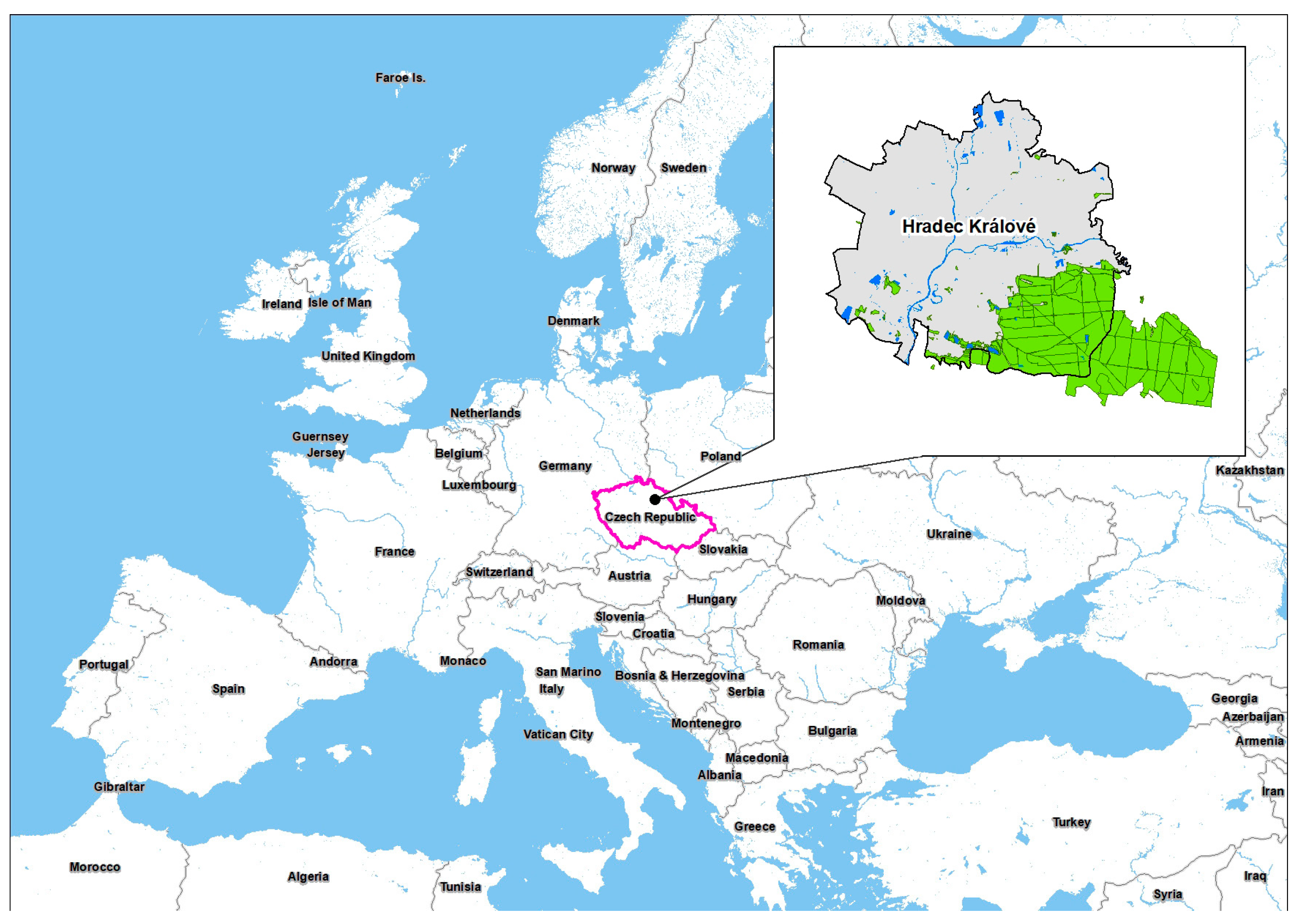

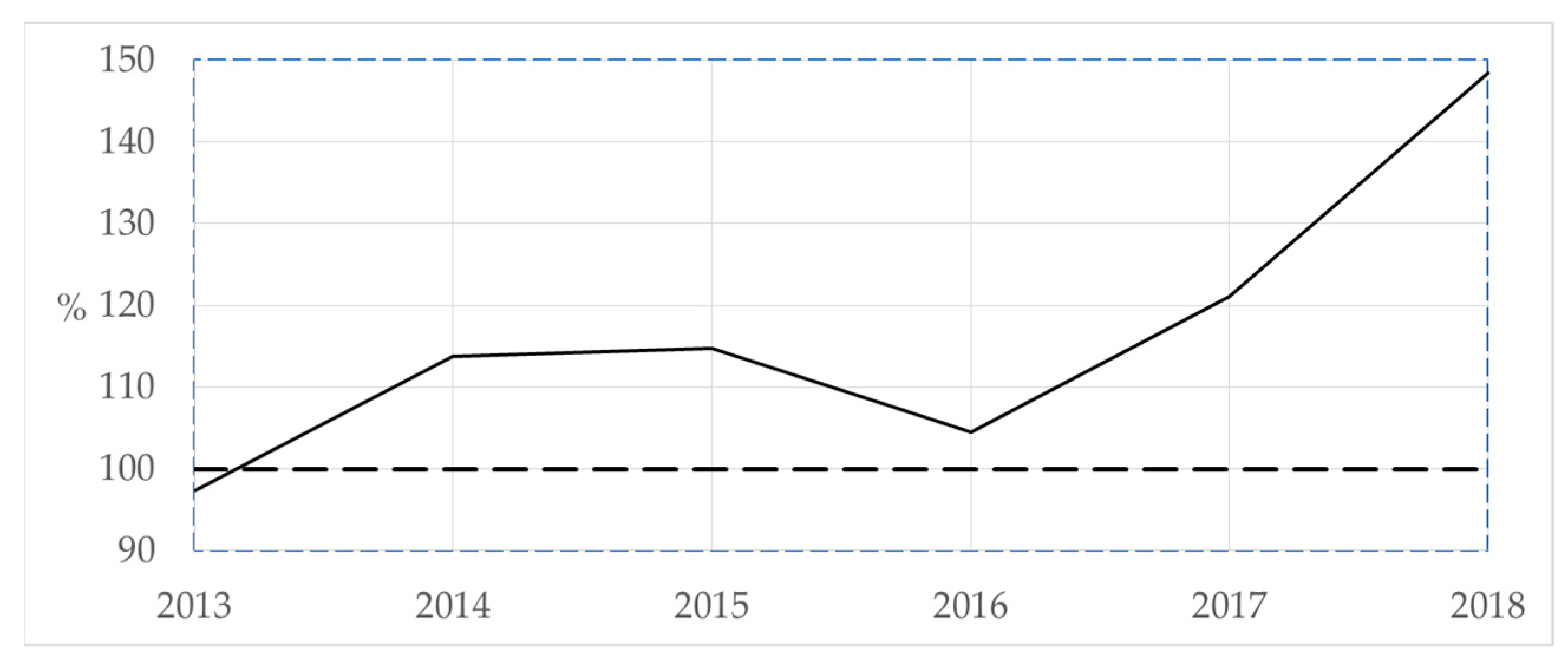
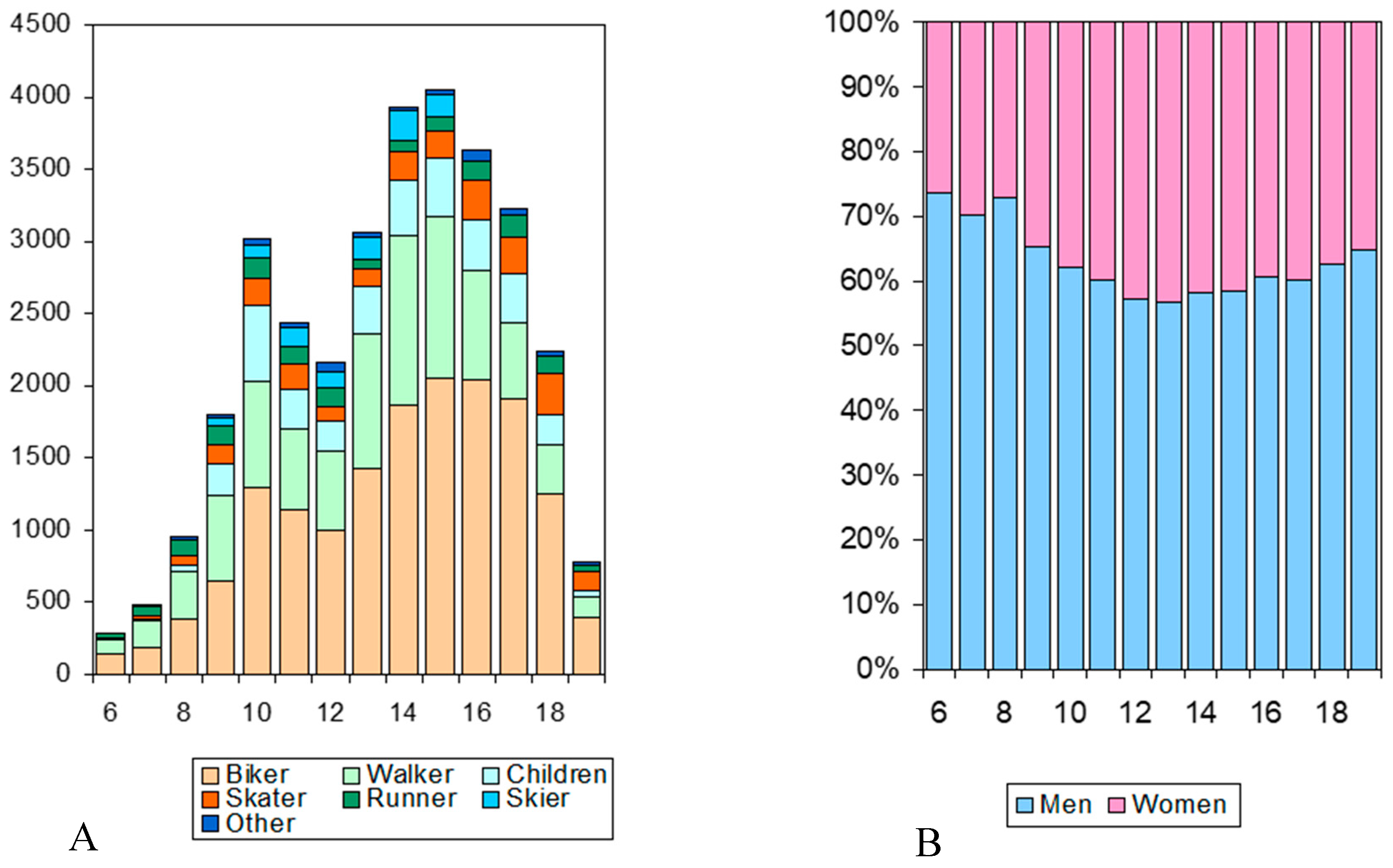
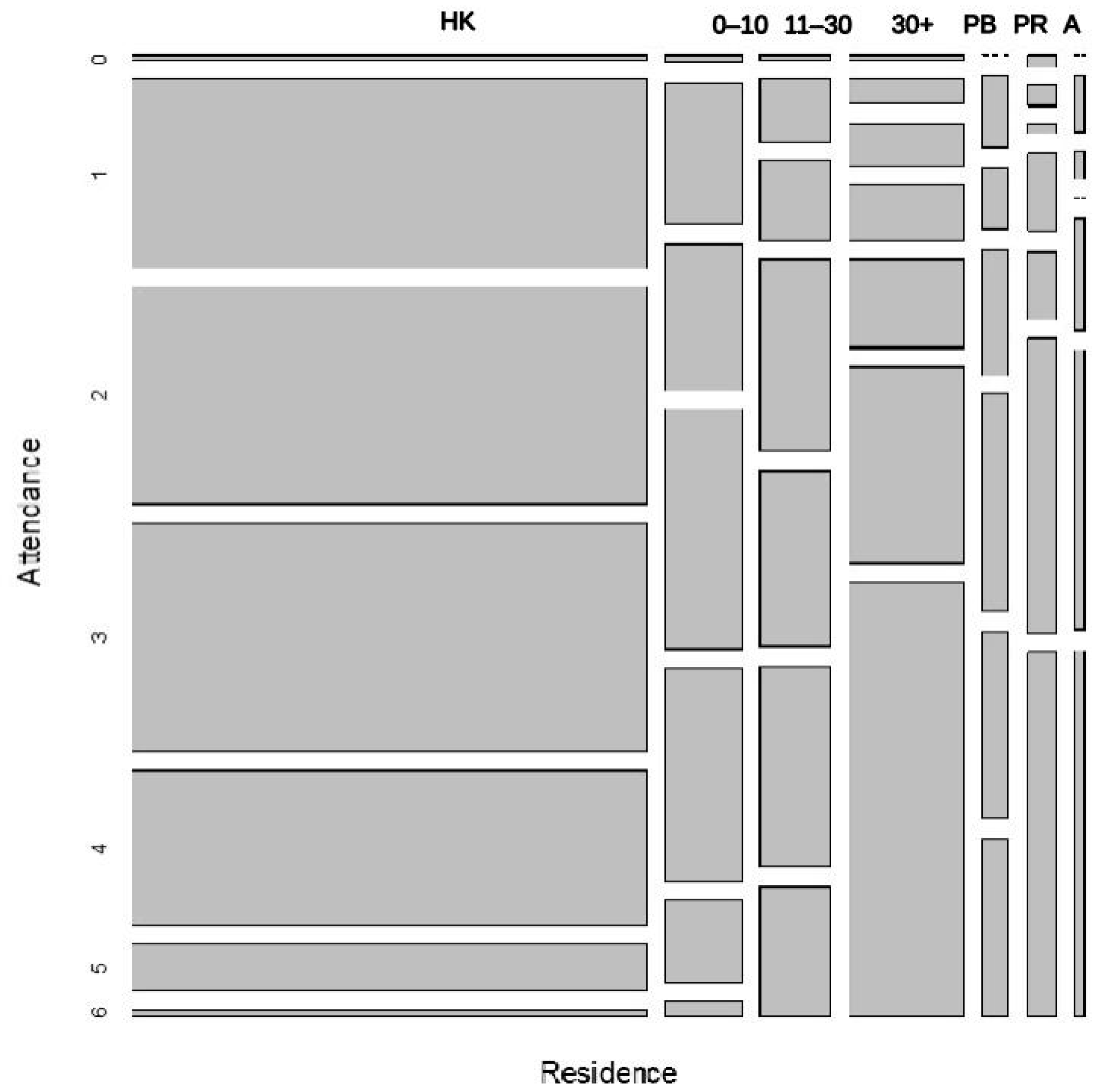
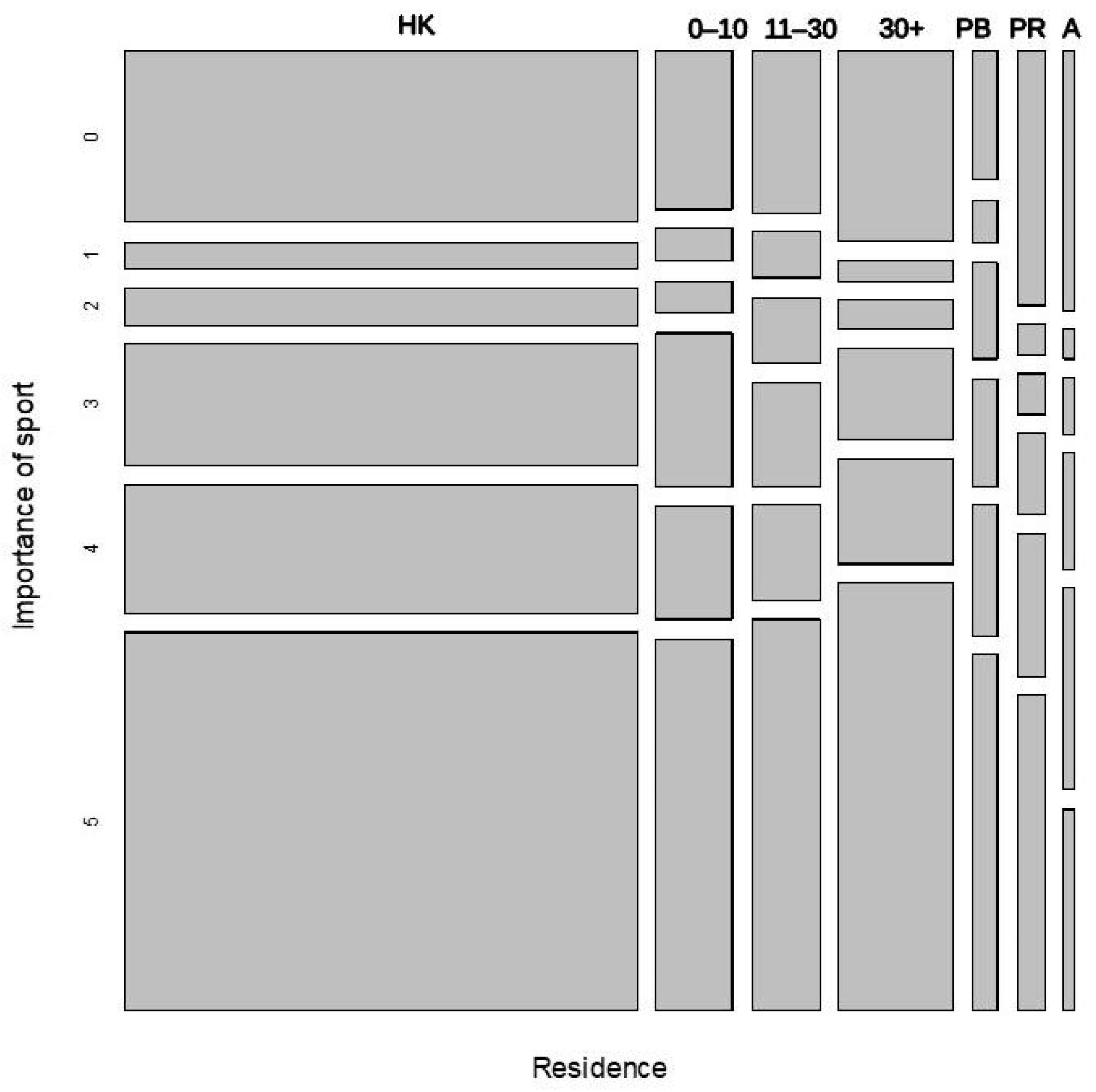
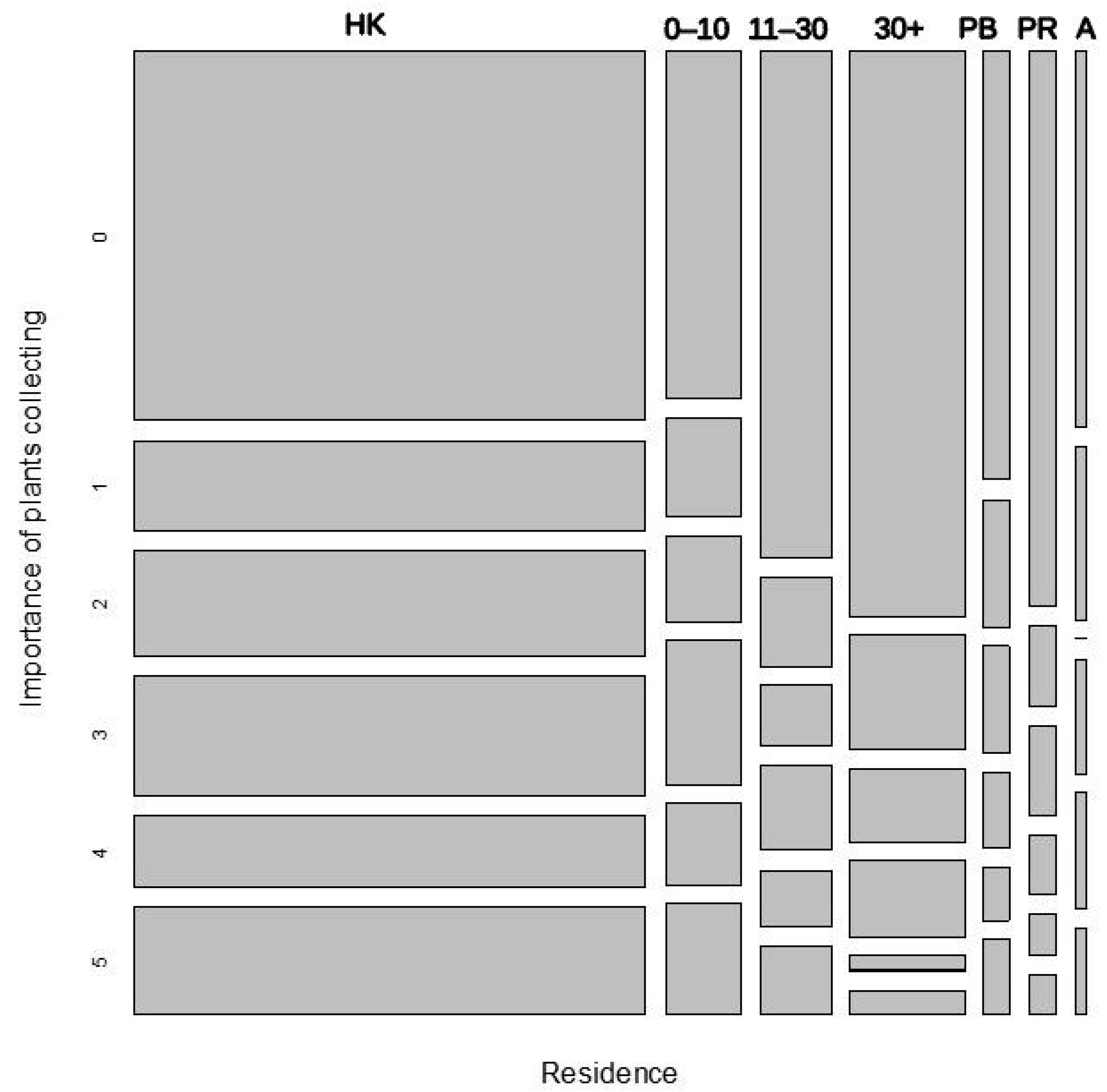
| Costs from 2019 (CZK) | Average Costs in 2013–2019 (CZK) | |
|---|---|---|
| Pedestrians | 57.02 | 120.60 |
| Pedestrians + runners | 48.51 | 102.59 |
| Cyclists | 43.10 | 92.57 |
| Cyclists + skaters | 37.86 | 81.32 |
| Year | Foreign Resources | Own Resources | Total in CZK | Total in EUR * | ||
|---|---|---|---|---|---|---|
| Subsidy | Recreation Service | Sales | ||||
| Sand | Firewood | |||||
| 2013 | 1153 | 120 | 682 | 4608 | 6563 | 253 |
| 2014 | 393 | 137 | 446 | 4018 | 4994 | 181 |
| 2015 | 0 | 189 | 685 | 4354 | 5228 | 192 |
| 2016 | 188 | 143 | 1576 | 3228 | 5135 | 190 |
| 2017 | 0 | 130 | 868 | 2873 | 3871 | 147 |
| 2018 | 236 | 213 | 847 | 2372 | 3668 | 143 |
| 2019 | 298 | 307 | 507 | 1458 | 2570 | 100 |
| Ø | 324 | 177 | 802 | 3273 | 4576 | 173 |
| % | 7.1 | 3.9 | 17.5 | 71.5 | 100 | |
| Year | Forest Management 1 | Sand Quarry | Other Activities 2 | Overhead Costs | Rent Paid to the City | Economic Result 3 | |
|---|---|---|---|---|---|---|---|
| 2013 | 20,383 | 3012 | −6503 | −12,838 | −3231 | 823 | 31.7 |
| 2014 | 23,948 | 2674 | −4607 | −18,193 | −3166 | 656 | 23.8 |
| 2015 | 17,752 | 2802 | −3452 | −13,409 | −3156 | 537 | 19.7 |
| 2016 | 9510 | 4656 | 815 | −11,262 | −3142 | 577 | 21.3 |
| 2017 | 14,961 | 4518 | −2623 | −13,163 | −3139 | 554 | 21.0 |
| 2018 | 11,948 | 4261 | 581 | −12,682 | −3159 | 949 | 37.0 |
| 2019 | 19,827 | 6892 | −2951 | −19,640 | −3167 | 961 | 37.4 |
| Ø | 16,904 | 4116 | −2677 | −14,455 | −3166 | 722 | 27.3 |
| Month | Biker | Walker | Children | Skater | Runner | Skier | Other Activity | All Activities |
|---|---|---|---|---|---|---|---|---|
| 1 | 0.4 | 12.7 | 4.4 | 0.0 | 5.6 | 99.4 | 0.7 | 6.9 |
| 2 | 0.1 | 2.3 | 2.6 | 0.0 | 2.4 | 0.6 | 0.9 | 1.0 |
| 3 | 0.9 | 4.3 | 1.8 | 0.4 | 8.2 | 0.0 | 17.7 | 2.3 |
| 4 | 2.9 | 5.1 | 2.5 | 1.7 | 7.6 | 0.0 | 8.5 | 3.6 |
| 5 | 7.1 | 5.9 | 9.2 | 8.5 | 10.9 | 0.0 | 6.9 | 7.1 |
| 6 | 24.4 | 14.7 | 18.2 | 23.3 | 11.3 | 0.0 | 13.4 | 19.8 |
| 7 | 22.2 | 15.6 | 19.1 | 27.7 | 9.5 | 0.0 | 16.3 | 19.3 |
| 8 | 14.6 | 11.4 | 14.0 | 18.2 | 12.8 | 0.0 | 15.7 | 13.5 |
| 9 | 23.9 | 14.9 | 21.5 | 18.6 | 7.9 | 0.0 | 12.8 | 19.5 |
| 10 | 1.5 | 3.8 | 2.1 | 0.7 | 6.9 | 0.0 | 4.3 | 2.3 |
| 11 | 0.9 | 5.7 | 2.8 | 0.6 | 14.1 | 0.0 | 1.3 | 2.9 |
| 12 | 0.9 | 3.5 | 1.9 | 0.3 | 2.9 | 0.0 | 1.6 | 1.7 |
| Total | 100.0 | 100.0 | 100.0 | 100.0 | 100.0 | 100.0 | 100.0 | 100.0 |
| Share of activity | 49.0 | 25.2 | 10.4 | 6.8 | 4.4 | 2.8 | 1.4 | 100.0 |
| Term | Coefficient | Explained Variability (%) | p-Value |
|---|---|---|---|
| Temperature | 0.709 | 4.2 | <2.10−16 |
| Precipitation | −2.395 | 3.0 | <4.10−12 |
| Day (Sat–Wed) | 10.144 | 3.6 | <2.10−16 |
| Control stand | 32.0 | ||
| Time | 7.9 |
| City | Country | Population (tis) | Acreage (ha) | Annual Allowable Cut m3/ha/year | Rec./Total Cost (%) | Source of Financing (%) | ||
|---|---|---|---|---|---|---|---|---|
| Wood | City | Other | ||||||
| Vienna | A | 1911 | 8650 | N/A | N/A | 13 | 75 | 21 1 |
| Hamburg | D | 1899 | 4365 | 3.5 | N/A | 2 | ||
| Warsaw | PL | 1791 | 3264 | 0.9 | 36 | - | 100 | - |
| Budapest | H | 1752 | 5450 | 3.0 | 11 | 100 | - | - |
| Prague | CZ | 1324 | 2746 | 4.7 | 60 | - | 100 | - |
| Krakow | PL | 779 | 606 | 2.5 | 40 | - | 100 | - |
| Dresden | D | 556 | 958 | 3.7 | 35 | - | 100 | - |
| Poznan | PL | 536 | 2566 | 2.1 | 60 | - | 100 | - |
| Bratislava | SK | 438 | 3061 | 1.7 | 72 | 20 3 | 80 | - |
| Zurich | CH | 434 | 2225 | 9.5 | 50 | N/A | ||
| Augsburg | D | 295 | 7700 | 8.5 | 10 | 98 4 | - | 2 5 |
| Mainz | D | 219 | 700 | 3.0 | 50 | 10 | 70 | 20 6 |
| Pilsen | CZ | 175 | 4111 | 4.7 | 21 | - | 100 | - |
| Hr. Králové | CZ | 92 | 3707 | 4.7 | 19.7 | 71.5 | - | 28.5 7 |
| Ban. Bystrica | SK | 78 | 7625 | 4.1 | 3 | 95 | - | 5 8 |
| Zvolen | SK | 43 | 1558 | 5.3 | 11 | 100 | - | - |
| Landsb. am L. | D | 29 | 2307 | 6.9 | 14 | 100 | - | - |
Publisher’s Note: MDPI stays neutral with regard to jurisdictional claims in published maps and institutional affiliations. |
© 2020 by the authors. Licensee MDPI, Basel, Switzerland. This article is an open access article distributed under the terms and conditions of the Creative Commons Attribution (CC BY) license (http://creativecommons.org/licenses/by/4.0/).
Share and Cite
Jůza, R.; Jarský, V.; Riedl, M.; Zahradník, D.; Šišák, L. Possibilities for Harmonisation between Recreation Services and Their Production within the Forest Sector—A Case Study of Municipal Forest Enterprise Hradec Králové (CZ). Forests 2021, 12, 13. https://doi.org/10.3390/f12010013
Jůza R, Jarský V, Riedl M, Zahradník D, Šišák L. Possibilities for Harmonisation between Recreation Services and Their Production within the Forest Sector—A Case Study of Municipal Forest Enterprise Hradec Králové (CZ). Forests. 2021; 12(1):13. https://doi.org/10.3390/f12010013
Chicago/Turabian StyleJůza, Radek, Vilém Jarský, Marcel Riedl, Daniel Zahradník, and Luděk Šišák. 2021. "Possibilities for Harmonisation between Recreation Services and Their Production within the Forest Sector—A Case Study of Municipal Forest Enterprise Hradec Králové (CZ)" Forests 12, no. 1: 13. https://doi.org/10.3390/f12010013
APA StyleJůza, R., Jarský, V., Riedl, M., Zahradník, D., & Šišák, L. (2021). Possibilities for Harmonisation between Recreation Services and Their Production within the Forest Sector—A Case Study of Municipal Forest Enterprise Hradec Králové (CZ). Forests, 12(1), 13. https://doi.org/10.3390/f12010013






